Analysis: 11 Impacts of Climate Change on Mumbai City, India
VerifiedAdded on 2020/03/23
|17
|3035
|44
Report
AI Summary
This report provides a detailed analysis of the multifaceted impacts of climate change on Mumbai, India. It begins with an executive summary highlighting the city's vulnerability due to its geographical location and high population density, emphasizing that urban areas are major contributors to greenhouse gas emissions. The report then delves into eleven key impacts, including changes in precipitation patterns leading to extreme droughts and floods, rising sea levels due to thermal expansion and melting glaciers, increased humidity and its effects on global warming, altered wind patterns impacting weather systems, and rising temperatures affecting seasonal rainfall and energy consumption. Furthermore, it explores the social implications, such as increased heat stress, vulnerability to diseases, and flooding impacting a significant portion of the population. The report also discusses the impact on food security, water resources, and the current mitigation strategies implemented by the government, while also acknowledging their limitations. The report uses figures and tables to illustrate the impacts, and concludes by presenting a comprehensive overview of the challenges and the need for effective adaptation measures in Mumbai.
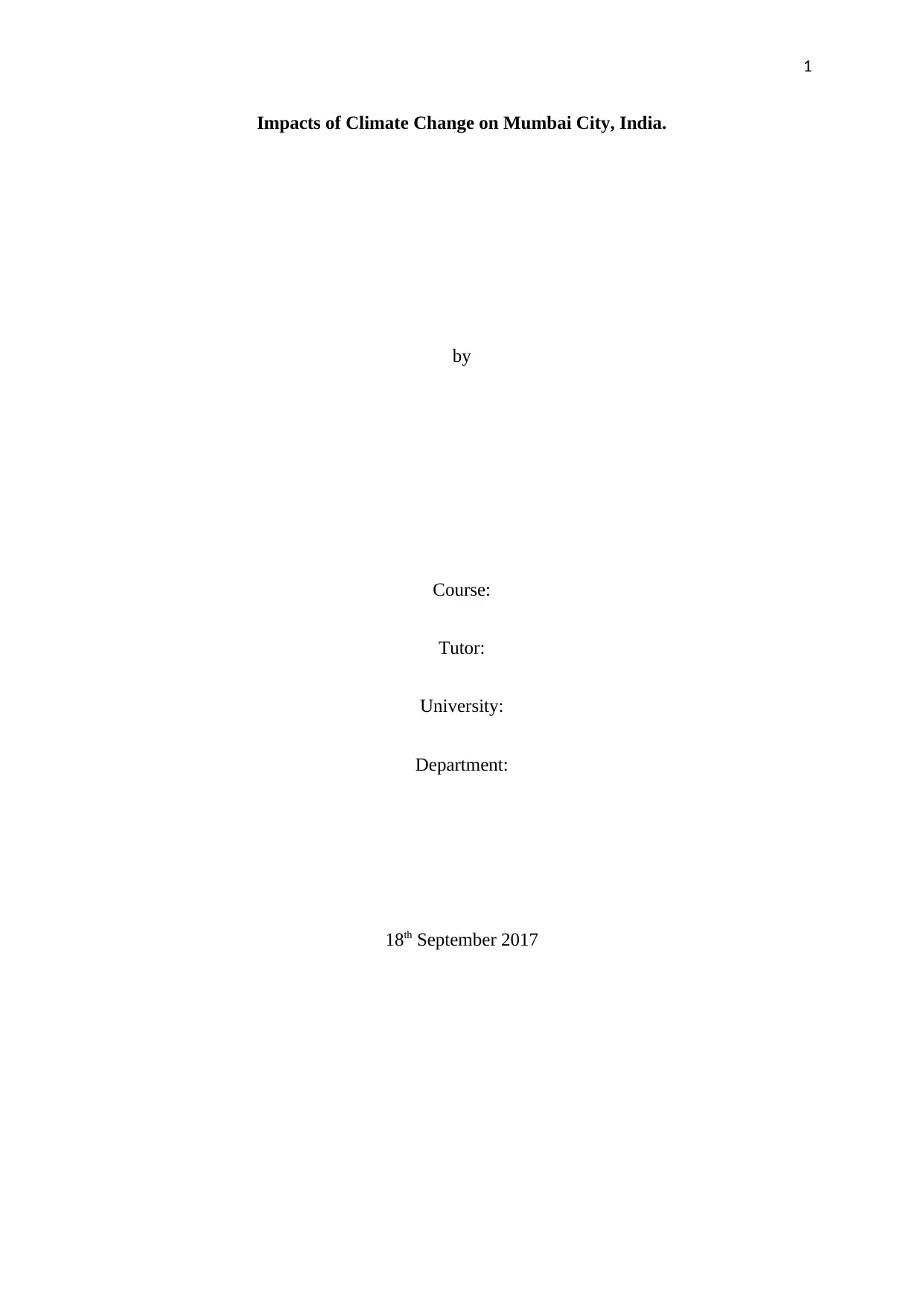
1
Impacts of Climate Change on Mumbai City, India.
by
Course:
Tutor:
University:
Department:
18th September 2017
Impacts of Climate Change on Mumbai City, India.
by
Course:
Tutor:
University:
Department:
18th September 2017
Paraphrase This Document
Need a fresh take? Get an instant paraphrase of this document with our AI Paraphraser
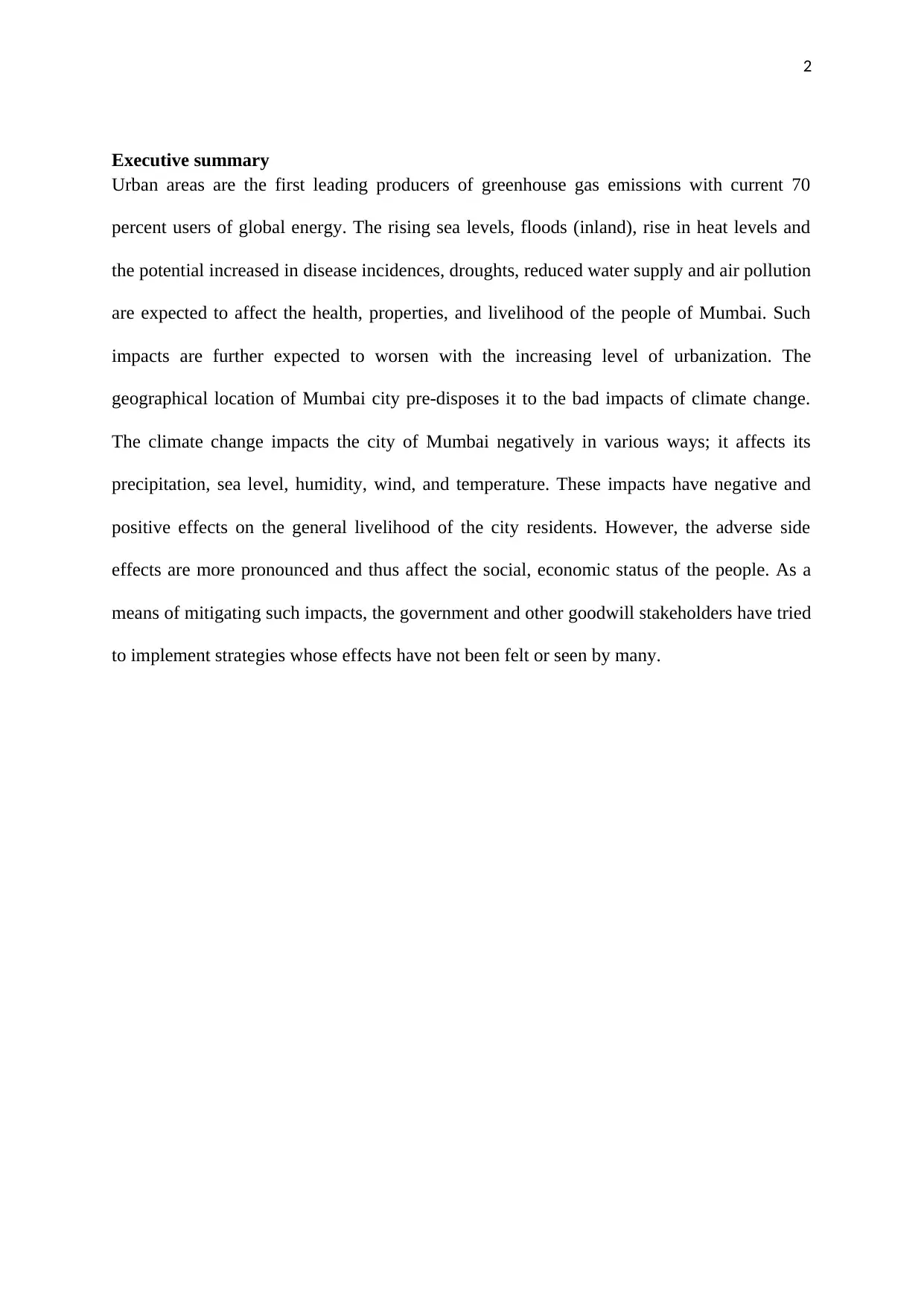
2
Executive summary
Urban areas are the first leading producers of greenhouse gas emissions with current 70
percent users of global energy. The rising sea levels, floods (inland), rise in heat levels and
the potential increased in disease incidences, droughts, reduced water supply and air pollution
are expected to affect the health, properties, and livelihood of the people of Mumbai. Such
impacts are further expected to worsen with the increasing level of urbanization. The
geographical location of Mumbai city pre-disposes it to the bad impacts of climate change.
The climate change impacts the city of Mumbai negatively in various ways; it affects its
precipitation, sea level, humidity, wind, and temperature. These impacts have negative and
positive effects on the general livelihood of the city residents. However, the adverse side
effects are more pronounced and thus affect the social, economic status of the people. As a
means of mitigating such impacts, the government and other goodwill stakeholders have tried
to implement strategies whose effects have not been felt or seen by many.
Executive summary
Urban areas are the first leading producers of greenhouse gas emissions with current 70
percent users of global energy. The rising sea levels, floods (inland), rise in heat levels and
the potential increased in disease incidences, droughts, reduced water supply and air pollution
are expected to affect the health, properties, and livelihood of the people of Mumbai. Such
impacts are further expected to worsen with the increasing level of urbanization. The
geographical location of Mumbai city pre-disposes it to the bad impacts of climate change.
The climate change impacts the city of Mumbai negatively in various ways; it affects its
precipitation, sea level, humidity, wind, and temperature. These impacts have negative and
positive effects on the general livelihood of the city residents. However, the adverse side
effects are more pronounced and thus affect the social, economic status of the people. As a
means of mitigating such impacts, the government and other goodwill stakeholders have tried
to implement strategies whose effects have not been felt or seen by many.
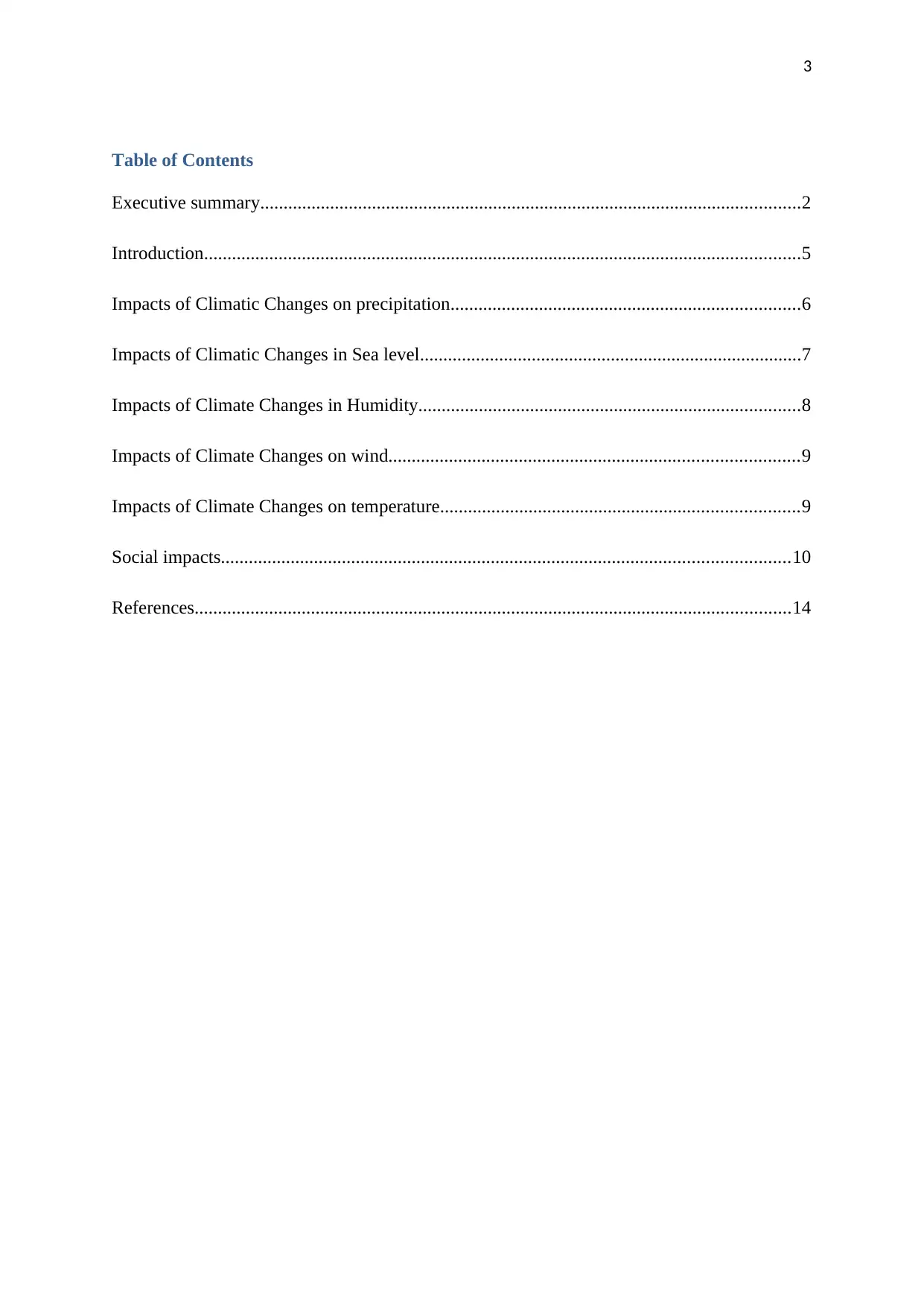
3
Table of Contents
Executive summary....................................................................................................................2
Introduction................................................................................................................................5
Impacts of Climatic Changes on precipitation...........................................................................6
Impacts of Climatic Changes in Sea level..................................................................................7
Impacts of Climate Changes in Humidity..................................................................................8
Impacts of Climate Changes on wind........................................................................................9
Impacts of Climate Changes on temperature.............................................................................9
Social impacts..........................................................................................................................10
References................................................................................................................................14
Table of Contents
Executive summary....................................................................................................................2
Introduction................................................................................................................................5
Impacts of Climatic Changes on precipitation...........................................................................6
Impacts of Climatic Changes in Sea level..................................................................................7
Impacts of Climate Changes in Humidity..................................................................................8
Impacts of Climate Changes on wind........................................................................................9
Impacts of Climate Changes on temperature.............................................................................9
Social impacts..........................................................................................................................10
References................................................................................................................................14
⊘ This is a preview!⊘
Do you want full access?
Subscribe today to unlock all pages.

Trusted by 1+ million students worldwide
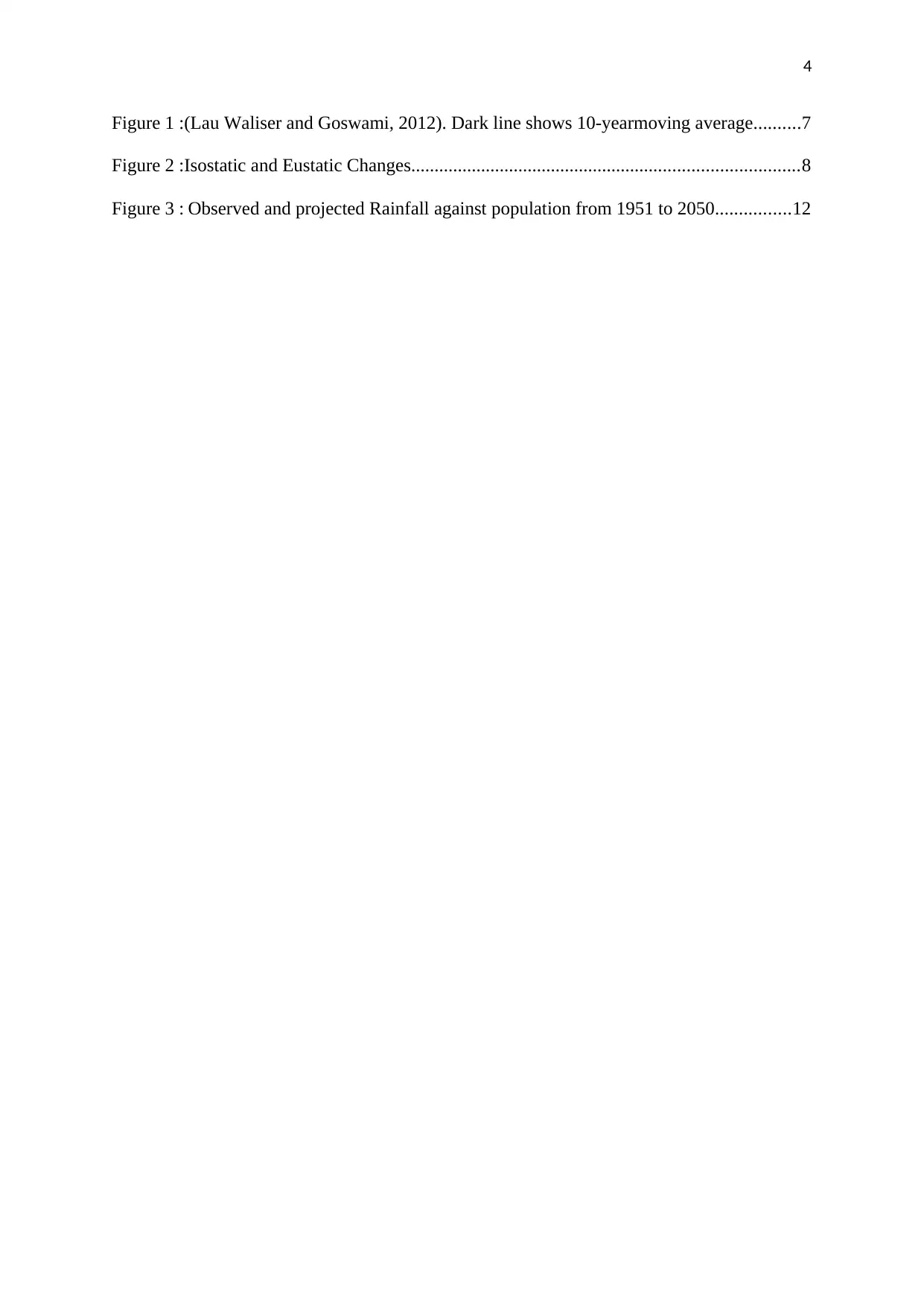
4
Figure 1 :(Lau Waliser and Goswami, 2012). Dark line shows 10-yearmoving average..........7
Figure 2 :Isostatic and Eustatic Changes...................................................................................8
Figure 3 : Observed and projected Rainfall against population from 1951 to 2050................12
Figure 1 :(Lau Waliser and Goswami, 2012). Dark line shows 10-yearmoving average..........7
Figure 2 :Isostatic and Eustatic Changes...................................................................................8
Figure 3 : Observed and projected Rainfall against population from 1951 to 2050................12
Paraphrase This Document
Need a fresh take? Get an instant paraphrase of this document with our AI Paraphraser
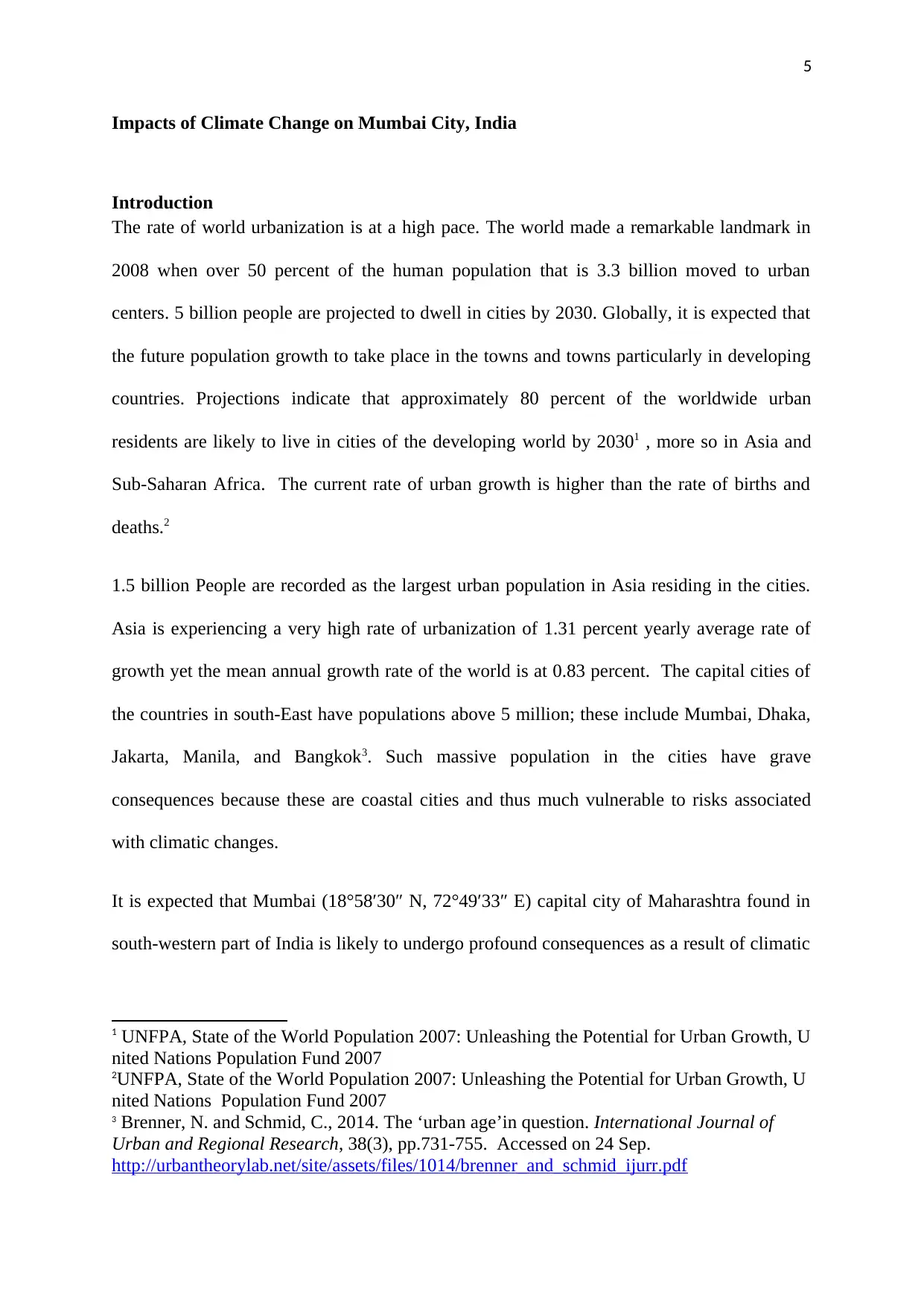
5
Impacts of Climate Change on Mumbai City, India
Introduction
The rate of world urbanization is at a high pace. The world made a remarkable landmark in
2008 when over 50 percent of the human population that is 3.3 billion moved to urban
centers. 5 billion people are projected to dwell in cities by 2030. Globally, it is expected that
the future population growth to take place in the towns and towns particularly in developing
countries. Projections indicate that approximately 80 percent of the worldwide urban
residents are likely to live in cities of the developing world by 20301 , more so in Asia and
Sub-Saharan Africa. The current rate of urban growth is higher than the rate of births and
deaths.2
1.5 billion People are recorded as the largest urban population in Asia residing in the cities.
Asia is experiencing a very high rate of urbanization of 1.31 percent yearly average rate of
growth yet the mean annual growth rate of the world is at 0.83 percent. The capital cities of
the countries in south-East have populations above 5 million; these include Mumbai, Dhaka,
Jakarta, Manila, and Bangkok3. Such massive population in the cities have grave
consequences because these are coastal cities and thus much vulnerable to risks associated
with climatic changes.
It is expected that Mumbai (18°58′30″ N, 72°49′33″ E) capital city of Maharashtra found in
south-western part of India is likely to undergo profound consequences as a result of climatic
1 UNFPA, State of the World Population 2007: Unleashing the Potential for Urban Growth, U
nited Nations Population Fund 2007
2UNFPA, State of the World Population 2007: Unleashing the Potential for Urban Growth, U
nited Nations Population Fund 2007
3 Brenner, N. and Schmid, C., 2014. The ‘urban age’in question. International Journal of
Urban and Regional Research, 38(3), pp.731-755. Accessed on 24 Sep.
http://urbantheorylab.net/site/assets/files/1014/brenner_and_schmid_ijurr.pdf
Impacts of Climate Change on Mumbai City, India
Introduction
The rate of world urbanization is at a high pace. The world made a remarkable landmark in
2008 when over 50 percent of the human population that is 3.3 billion moved to urban
centers. 5 billion people are projected to dwell in cities by 2030. Globally, it is expected that
the future population growth to take place in the towns and towns particularly in developing
countries. Projections indicate that approximately 80 percent of the worldwide urban
residents are likely to live in cities of the developing world by 20301 , more so in Asia and
Sub-Saharan Africa. The current rate of urban growth is higher than the rate of births and
deaths.2
1.5 billion People are recorded as the largest urban population in Asia residing in the cities.
Asia is experiencing a very high rate of urbanization of 1.31 percent yearly average rate of
growth yet the mean annual growth rate of the world is at 0.83 percent. The capital cities of
the countries in south-East have populations above 5 million; these include Mumbai, Dhaka,
Jakarta, Manila, and Bangkok3. Such massive population in the cities have grave
consequences because these are coastal cities and thus much vulnerable to risks associated
with climatic changes.
It is expected that Mumbai (18°58′30″ N, 72°49′33″ E) capital city of Maharashtra found in
south-western part of India is likely to undergo profound consequences as a result of climatic
1 UNFPA, State of the World Population 2007: Unleashing the Potential for Urban Growth, U
nited Nations Population Fund 2007
2UNFPA, State of the World Population 2007: Unleashing the Potential for Urban Growth, U
nited Nations Population Fund 2007
3 Brenner, N. and Schmid, C., 2014. The ‘urban age’in question. International Journal of
Urban and Regional Research, 38(3), pp.731-755. Accessed on 24 Sep.
http://urbantheorylab.net/site/assets/files/1014/brenner_and_schmid_ijurr.pdf
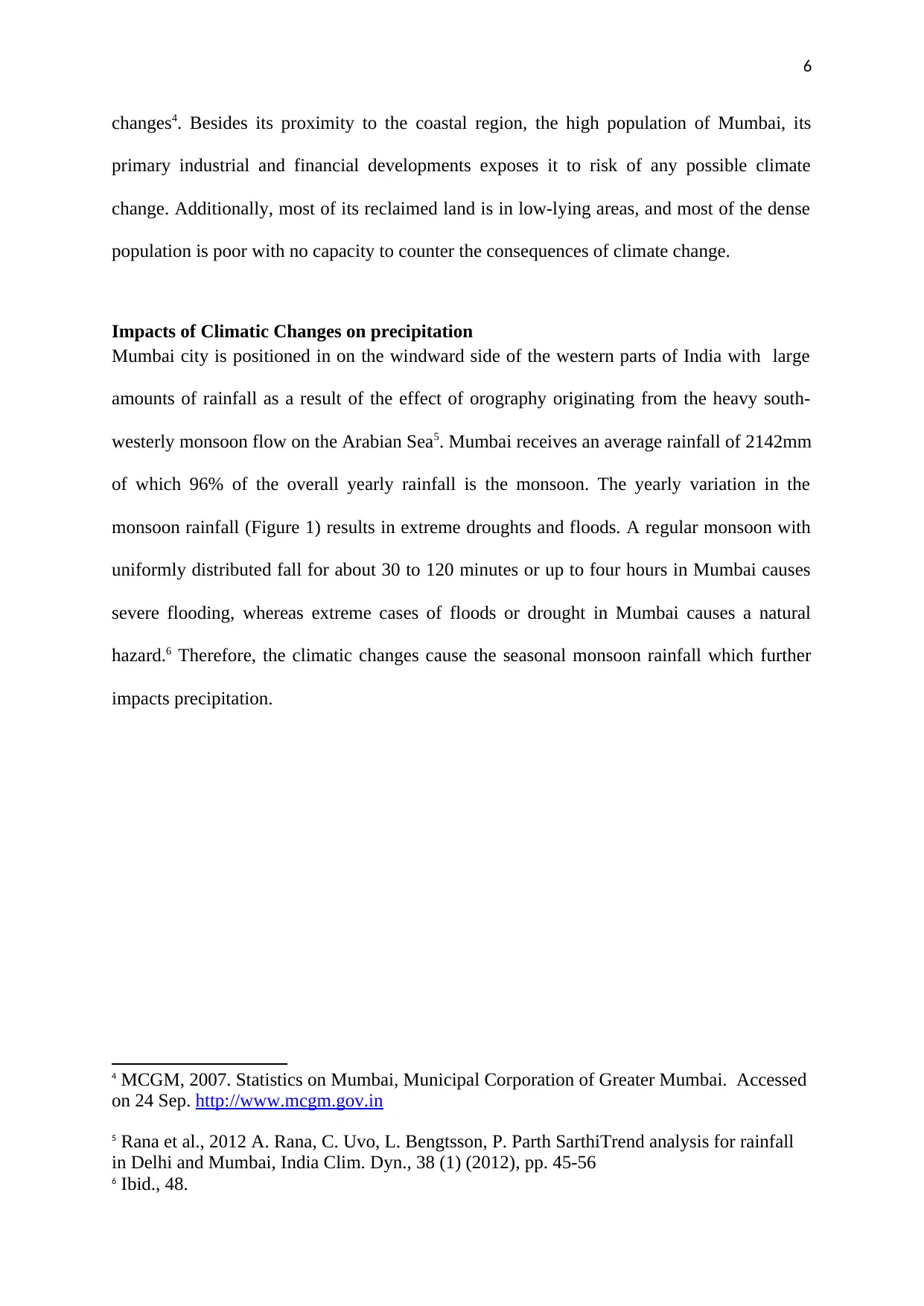
6
changes4. Besides its proximity to the coastal region, the high population of Mumbai, its
primary industrial and financial developments exposes it to risk of any possible climate
change. Additionally, most of its reclaimed land is in low-lying areas, and most of the dense
population is poor with no capacity to counter the consequences of climate change.
Impacts of Climatic Changes on precipitation
Mumbai city is positioned in on the windward side of the western parts of India with large
amounts of rainfall as a result of the effect of orography originating from the heavy south-
westerly monsoon flow on the Arabian Sea5. Mumbai receives an average rainfall of 2142mm
of which 96% of the overall yearly rainfall is the monsoon. The yearly variation in the
monsoon rainfall (Figure 1) results in extreme droughts and floods. A regular monsoon with
uniformly distributed fall for about 30 to 120 minutes or up to four hours in Mumbai causes
severe flooding, whereas extreme cases of floods or drought in Mumbai causes a natural
hazard.6 Therefore, the climatic changes cause the seasonal monsoon rainfall which further
impacts precipitation.
4 MCGM, 2007. Statistics on Mumbai, Municipal Corporation of Greater Mumbai. Accessed
on 24 Sep. http://www.mcgm.gov.in
5 Rana et al., 2012 A. Rana, C. Uvo, L. Bengtsson, P. Parth SarthiTrend analysis for rainfall
in Delhi and Mumbai, India Clim. Dyn., 38 (1) (2012), pp. 45-56
6 Ibid., 48.
changes4. Besides its proximity to the coastal region, the high population of Mumbai, its
primary industrial and financial developments exposes it to risk of any possible climate
change. Additionally, most of its reclaimed land is in low-lying areas, and most of the dense
population is poor with no capacity to counter the consequences of climate change.
Impacts of Climatic Changes on precipitation
Mumbai city is positioned in on the windward side of the western parts of India with large
amounts of rainfall as a result of the effect of orography originating from the heavy south-
westerly monsoon flow on the Arabian Sea5. Mumbai receives an average rainfall of 2142mm
of which 96% of the overall yearly rainfall is the monsoon. The yearly variation in the
monsoon rainfall (Figure 1) results in extreme droughts and floods. A regular monsoon with
uniformly distributed fall for about 30 to 120 minutes or up to four hours in Mumbai causes
severe flooding, whereas extreme cases of floods or drought in Mumbai causes a natural
hazard.6 Therefore, the climatic changes cause the seasonal monsoon rainfall which further
impacts precipitation.
4 MCGM, 2007. Statistics on Mumbai, Municipal Corporation of Greater Mumbai. Accessed
on 24 Sep. http://www.mcgm.gov.in
5 Rana et al., 2012 A. Rana, C. Uvo, L. Bengtsson, P. Parth SarthiTrend analysis for rainfall
in Delhi and Mumbai, India Clim. Dyn., 38 (1) (2012), pp. 45-56
6 Ibid., 48.
⊘ This is a preview!⊘
Do you want full access?
Subscribe today to unlock all pages.

Trusted by 1+ million students worldwide
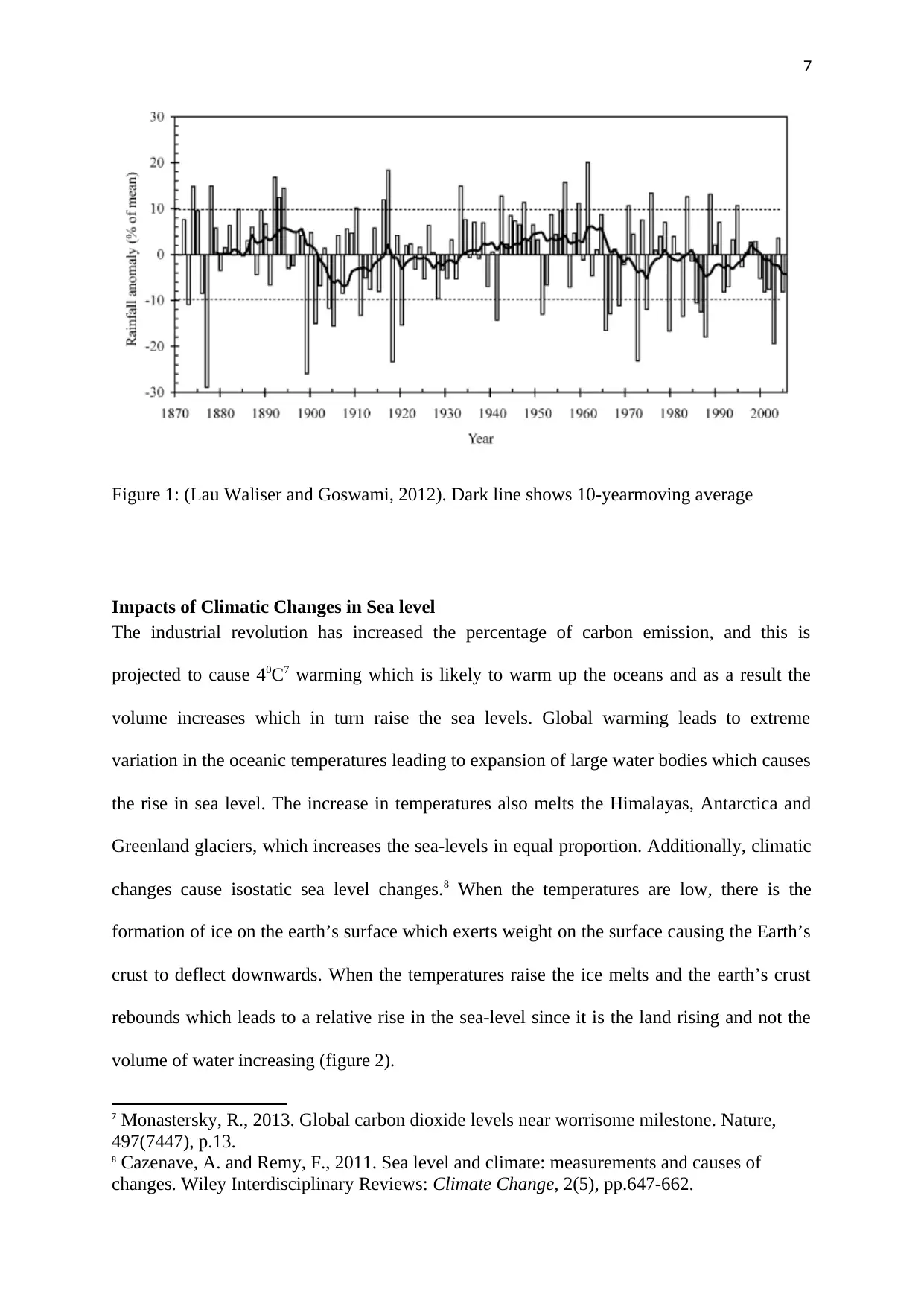
7
Figure 1: (Lau Waliser and Goswami, 2012). Dark line shows 10-yearmoving average
Figure 1Figure 1: (Lau Waliser and Goswami, 2012). Dark line shows 10-yearmoving average
Impacts of Climatic Changes in Sea level
The industrial revolution has increased the percentage of carbon emission, and this is
projected to cause 40C7 warming which is likely to warm up the oceans and as a result the
volume increases which in turn raise the sea levels. Global warming leads to extreme
variation in the oceanic temperatures leading to expansion of large water bodies which causes
the rise in sea level. The increase in temperatures also melts the Himalayas, Antarctica and
Greenland glaciers, which increases the sea-levels in equal proportion. Additionally, climatic
changes cause isostatic sea level changes.8 When the temperatures are low, there is the
formation of ice on the earth’s surface which exerts weight on the surface causing the Earth’s
crust to deflect downwards. When the temperatures raise the ice melts and the earth’s crust
rebounds which leads to a relative rise in the sea-level since it is the land rising and not the
volume of water increasing (figure 2).
7 Monastersky, R., 2013. Global carbon dioxide levels near worrisome milestone. Nature,
497(7447), p.13.
8 Cazenave, A. and Remy, F., 2011. Sea level and climate: measurements and causes of
changes. Wiley Interdisciplinary Reviews: Climate Change, 2(5), pp.647-662.
Figure 1: (Lau Waliser and Goswami, 2012). Dark line shows 10-yearmoving average
Figure 1Figure 1: (Lau Waliser and Goswami, 2012). Dark line shows 10-yearmoving average
Impacts of Climatic Changes in Sea level
The industrial revolution has increased the percentage of carbon emission, and this is
projected to cause 40C7 warming which is likely to warm up the oceans and as a result the
volume increases which in turn raise the sea levels. Global warming leads to extreme
variation in the oceanic temperatures leading to expansion of large water bodies which causes
the rise in sea level. The increase in temperatures also melts the Himalayas, Antarctica and
Greenland glaciers, which increases the sea-levels in equal proportion. Additionally, climatic
changes cause isostatic sea level changes.8 When the temperatures are low, there is the
formation of ice on the earth’s surface which exerts weight on the surface causing the Earth’s
crust to deflect downwards. When the temperatures raise the ice melts and the earth’s crust
rebounds which leads to a relative rise in the sea-level since it is the land rising and not the
volume of water increasing (figure 2).
7 Monastersky, R., 2013. Global carbon dioxide levels near worrisome milestone. Nature,
497(7447), p.13.
8 Cazenave, A. and Remy, F., 2011. Sea level and climate: measurements and causes of
changes. Wiley Interdisciplinary Reviews: Climate Change, 2(5), pp.647-662.
Paraphrase This Document
Need a fresh take? Get an instant paraphrase of this document with our AI Paraphraser
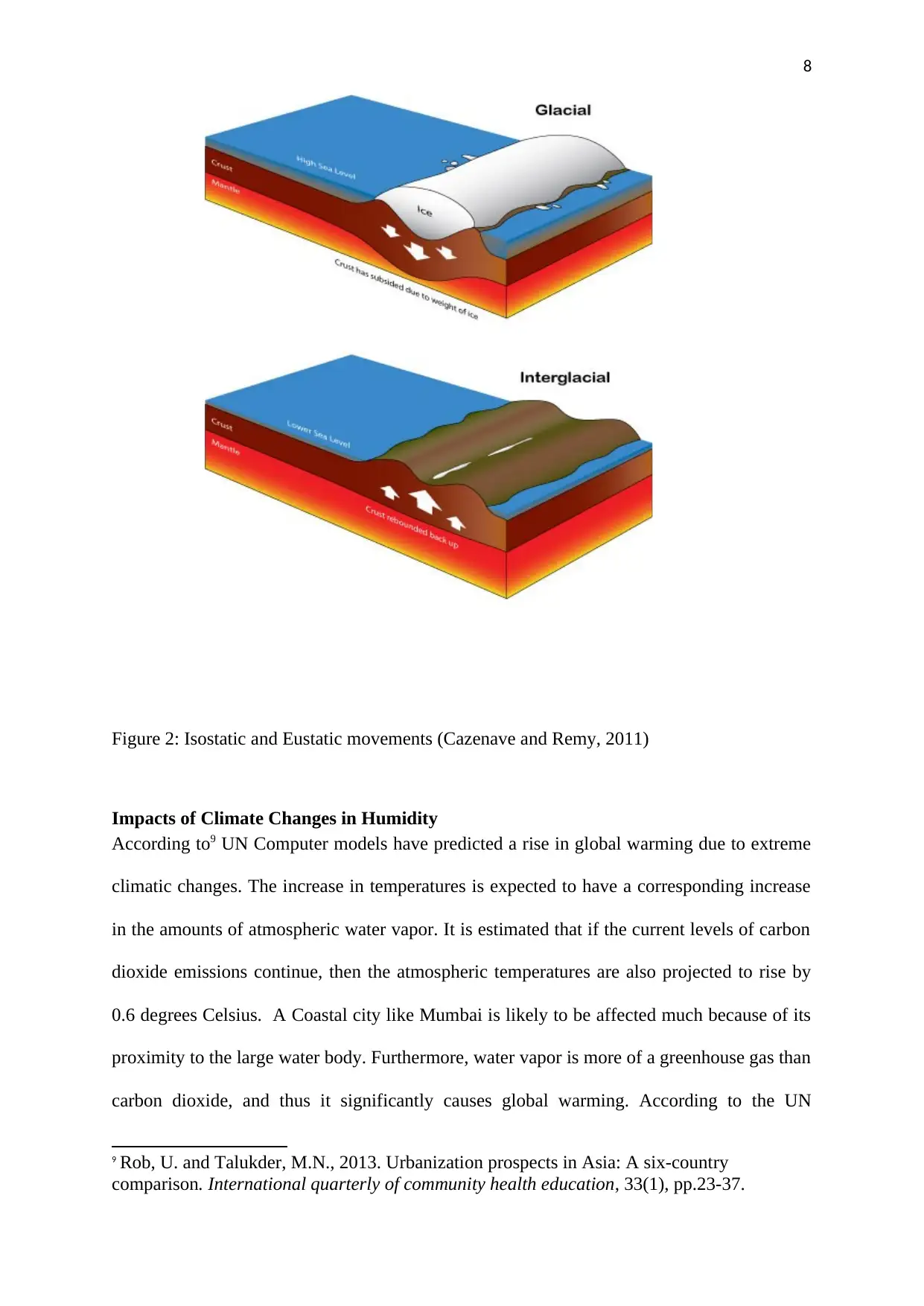
8
Figure 2: Isostatic and Eustatic Changes
Figure 2Figure 2: Isostatic and Eustatic Changes
Figure 2: Isostatic and Eustatic movements (Cazenave and Remy, 2011)
Impacts of Climate Changes in Humidity
According to9 UN Computer models have predicted a rise in global warming due to extreme
climatic changes. The increase in temperatures is expected to have a corresponding increase
in the amounts of atmospheric water vapor. It is estimated that if the current levels of carbon
dioxide emissions continue, then the atmospheric temperatures are also projected to rise by
0.6 degrees Celsius. A Coastal city like Mumbai is likely to be affected much because of its
proximity to the large water body. Furthermore, water vapor is more of a greenhouse gas than
carbon dioxide, and thus it significantly causes global warming. According to the UN
9 Rob, U. and Talukder, M.N., 2013. Urbanization prospects in Asia: A six-country
comparison. International quarterly of community health education, 33(1), pp.23-37.
Figure 2: Isostatic and Eustatic Changes
Figure 2Figure 2: Isostatic and Eustatic Changes
Figure 2: Isostatic and Eustatic movements (Cazenave and Remy, 2011)
Impacts of Climate Changes in Humidity
According to9 UN Computer models have predicted a rise in global warming due to extreme
climatic changes. The increase in temperatures is expected to have a corresponding increase
in the amounts of atmospheric water vapor. It is estimated that if the current levels of carbon
dioxide emissions continue, then the atmospheric temperatures are also projected to rise by
0.6 degrees Celsius. A Coastal city like Mumbai is likely to be affected much because of its
proximity to the large water body. Furthermore, water vapor is more of a greenhouse gas than
carbon dioxide, and thus it significantly causes global warming. According to the UN
9 Rob, U. and Talukder, M.N., 2013. Urbanization prospects in Asia: A six-country
comparison. International quarterly of community health education, 33(1), pp.23-37.
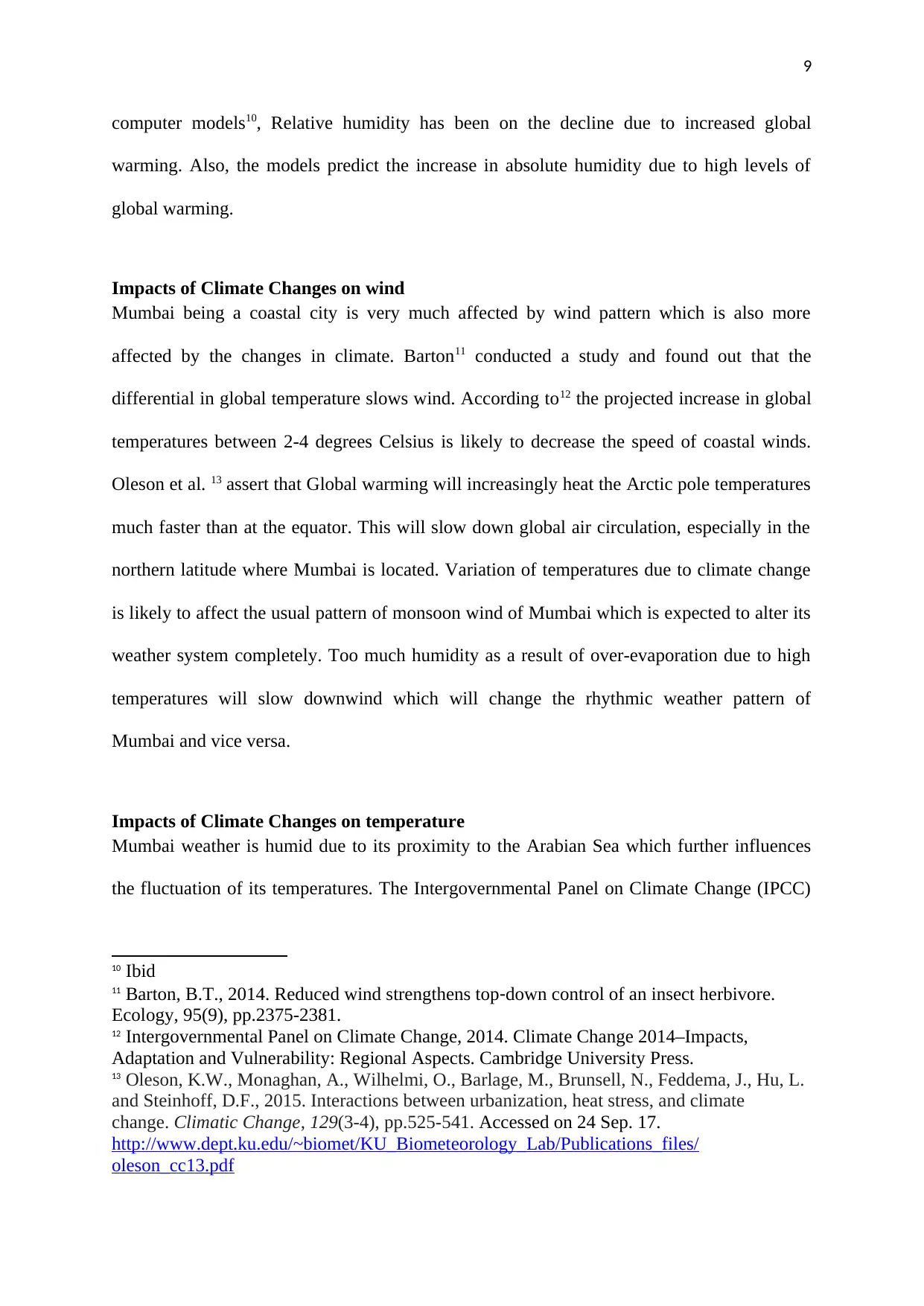
9
computer models10, Relative humidity has been on the decline due to increased global
warming. Also, the models predict the increase in absolute humidity due to high levels of
global warming.
Impacts of Climate Changes on wind
Mumbai being a coastal city is very much affected by wind pattern which is also more
affected by the changes in climate. Barton11 conducted a study and found out that the
differential in global temperature slows wind. According to12 the projected increase in global
temperatures between 2-4 degrees Celsius is likely to decrease the speed of coastal winds.
Oleson et al. 13 assert that Global warming will increasingly heat the Arctic pole temperatures
much faster than at the equator. This will slow down global air circulation, especially in the
northern latitude where Mumbai is located. Variation of temperatures due to climate change
is likely to affect the usual pattern of monsoon wind of Mumbai which is expected to alter its
weather system completely. Too much humidity as a result of over-evaporation due to high
temperatures will slow downwind which will change the rhythmic weather pattern of
Mumbai and vice versa.
Impacts of Climate Changes on temperature
Mumbai weather is humid due to its proximity to the Arabian Sea which further influences
the fluctuation of its temperatures. The Intergovernmental Panel on Climate Change (IPCC)
10 Ibid
11 Barton, B.T., 2014. Reduced wind strengthens top‐down control of an insect herbivore.
Ecology, 95(9), pp.2375-2381.
12 Intergovernmental Panel on Climate Change, 2014. Climate Change 2014–Impacts,
Adaptation and Vulnerability: Regional Aspects. Cambridge University Press.
13 Oleson, K.W., Monaghan, A., Wilhelmi, O., Barlage, M., Brunsell, N., Feddema, J., Hu, L.
and Steinhoff, D.F., 2015. Interactions between urbanization, heat stress, and climate
change. Climatic Change, 129(3-4), pp.525-541. Accessed on 24 Sep. 17.
http://www.dept.ku.edu/~biomet/KU_Biometeorology_Lab/Publications_files/
oleson_cc13.pdf
computer models10, Relative humidity has been on the decline due to increased global
warming. Also, the models predict the increase in absolute humidity due to high levels of
global warming.
Impacts of Climate Changes on wind
Mumbai being a coastal city is very much affected by wind pattern which is also more
affected by the changes in climate. Barton11 conducted a study and found out that the
differential in global temperature slows wind. According to12 the projected increase in global
temperatures between 2-4 degrees Celsius is likely to decrease the speed of coastal winds.
Oleson et al. 13 assert that Global warming will increasingly heat the Arctic pole temperatures
much faster than at the equator. This will slow down global air circulation, especially in the
northern latitude where Mumbai is located. Variation of temperatures due to climate change
is likely to affect the usual pattern of monsoon wind of Mumbai which is expected to alter its
weather system completely. Too much humidity as a result of over-evaporation due to high
temperatures will slow downwind which will change the rhythmic weather pattern of
Mumbai and vice versa.
Impacts of Climate Changes on temperature
Mumbai weather is humid due to its proximity to the Arabian Sea which further influences
the fluctuation of its temperatures. The Intergovernmental Panel on Climate Change (IPCC)
10 Ibid
11 Barton, B.T., 2014. Reduced wind strengthens top‐down control of an insect herbivore.
Ecology, 95(9), pp.2375-2381.
12 Intergovernmental Panel on Climate Change, 2014. Climate Change 2014–Impacts,
Adaptation and Vulnerability: Regional Aspects. Cambridge University Press.
13 Oleson, K.W., Monaghan, A., Wilhelmi, O., Barlage, M., Brunsell, N., Feddema, J., Hu, L.
and Steinhoff, D.F., 2015. Interactions between urbanization, heat stress, and climate
change. Climatic Change, 129(3-4), pp.525-541. Accessed on 24 Sep. 17.
http://www.dept.ku.edu/~biomet/KU_Biometeorology_Lab/Publications_files/
oleson_cc13.pdf
⊘ This is a preview!⊘
Do you want full access?
Subscribe today to unlock all pages.

Trusted by 1+ million students worldwide
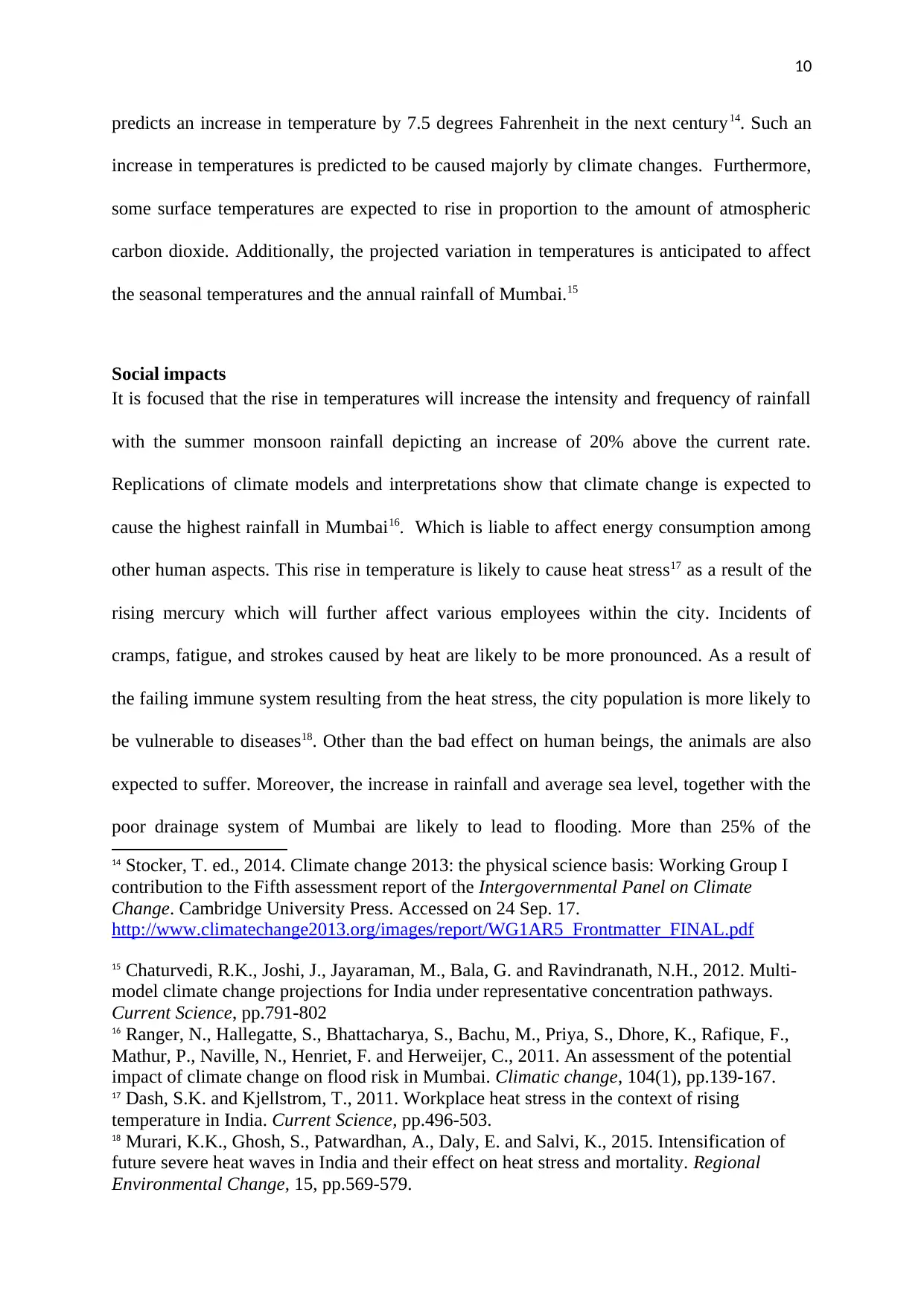
10
predicts an increase in temperature by 7.5 degrees Fahrenheit in the next century14. Such an
increase in temperatures is predicted to be caused majorly by climate changes. Furthermore,
some surface temperatures are expected to rise in proportion to the amount of atmospheric
carbon dioxide. Additionally, the projected variation in temperatures is anticipated to affect
the seasonal temperatures and the annual rainfall of Mumbai.15
Social impacts
It is focused that the rise in temperatures will increase the intensity and frequency of rainfall
with the summer monsoon rainfall depicting an increase of 20% above the current rate.
Replications of climate models and interpretations show that climate change is expected to
cause the highest rainfall in Mumbai16. Which is liable to affect energy consumption among
other human aspects. This rise in temperature is likely to cause heat stress17 as a result of the
rising mercury which will further affect various employees within the city. Incidents of
cramps, fatigue, and strokes caused by heat are likely to be more pronounced. As a result of
the failing immune system resulting from the heat stress, the city population is more likely to
be vulnerable to diseases18. Other than the bad effect on human beings, the animals are also
expected to suffer. Moreover, the increase in rainfall and average sea level, together with the
poor drainage system of Mumbai are likely to lead to flooding. More than 25% of the
14 Stocker, T. ed., 2014. Climate change 2013: the physical science basis: Working Group I
contribution to the Fifth assessment report of the Intergovernmental Panel on Climate
Change. Cambridge University Press. Accessed on 24 Sep. 17.
http://www.climatechange2013.org/images/report/WG1AR5_Frontmatter_FINAL.pdf
15 Chaturvedi, R.K., Joshi, J., Jayaraman, M., Bala, G. and Ravindranath, N.H., 2012. Multi-
model climate change projections for India under representative concentration pathways.
Current Science, pp.791-802
16 Ranger, N., Hallegatte, S., Bhattacharya, S., Bachu, M., Priya, S., Dhore, K., Rafique, F.,
Mathur, P., Naville, N., Henriet, F. and Herweijer, C., 2011. An assessment of the potential
impact of climate change on flood risk in Mumbai. Climatic change, 104(1), pp.139-167.
17 Dash, S.K. and Kjellstrom, T., 2011. Workplace heat stress in the context of rising
temperature in India. Current Science, pp.496-503.
18 Murari, K.K., Ghosh, S., Patwardhan, A., Daly, E. and Salvi, K., 2015. Intensification of
future severe heat waves in India and their effect on heat stress and mortality. Regional
Environmental Change, 15, pp.569-579.
predicts an increase in temperature by 7.5 degrees Fahrenheit in the next century14. Such an
increase in temperatures is predicted to be caused majorly by climate changes. Furthermore,
some surface temperatures are expected to rise in proportion to the amount of atmospheric
carbon dioxide. Additionally, the projected variation in temperatures is anticipated to affect
the seasonal temperatures and the annual rainfall of Mumbai.15
Social impacts
It is focused that the rise in temperatures will increase the intensity and frequency of rainfall
with the summer monsoon rainfall depicting an increase of 20% above the current rate.
Replications of climate models and interpretations show that climate change is expected to
cause the highest rainfall in Mumbai16. Which is liable to affect energy consumption among
other human aspects. This rise in temperature is likely to cause heat stress17 as a result of the
rising mercury which will further affect various employees within the city. Incidents of
cramps, fatigue, and strokes caused by heat are likely to be more pronounced. As a result of
the failing immune system resulting from the heat stress, the city population is more likely to
be vulnerable to diseases18. Other than the bad effect on human beings, the animals are also
expected to suffer. Moreover, the increase in rainfall and average sea level, together with the
poor drainage system of Mumbai are likely to lead to flooding. More than 25% of the
14 Stocker, T. ed., 2014. Climate change 2013: the physical science basis: Working Group I
contribution to the Fifth assessment report of the Intergovernmental Panel on Climate
Change. Cambridge University Press. Accessed on 24 Sep. 17.
http://www.climatechange2013.org/images/report/WG1AR5_Frontmatter_FINAL.pdf
15 Chaturvedi, R.K., Joshi, J., Jayaraman, M., Bala, G. and Ravindranath, N.H., 2012. Multi-
model climate change projections for India under representative concentration pathways.
Current Science, pp.791-802
16 Ranger, N., Hallegatte, S., Bhattacharya, S., Bachu, M., Priya, S., Dhore, K., Rafique, F.,
Mathur, P., Naville, N., Henriet, F. and Herweijer, C., 2011. An assessment of the potential
impact of climate change on flood risk in Mumbai. Climatic change, 104(1), pp.139-167.
17 Dash, S.K. and Kjellstrom, T., 2011. Workplace heat stress in the context of rising
temperature in India. Current Science, pp.496-503.
18 Murari, K.K., Ghosh, S., Patwardhan, A., Daly, E. and Salvi, K., 2015. Intensification of
future severe heat waves in India and their effect on heat stress and mortality. Regional
Environmental Change, 15, pp.569-579.
Paraphrase This Document
Need a fresh take? Get an instant paraphrase of this document with our AI Paraphraser
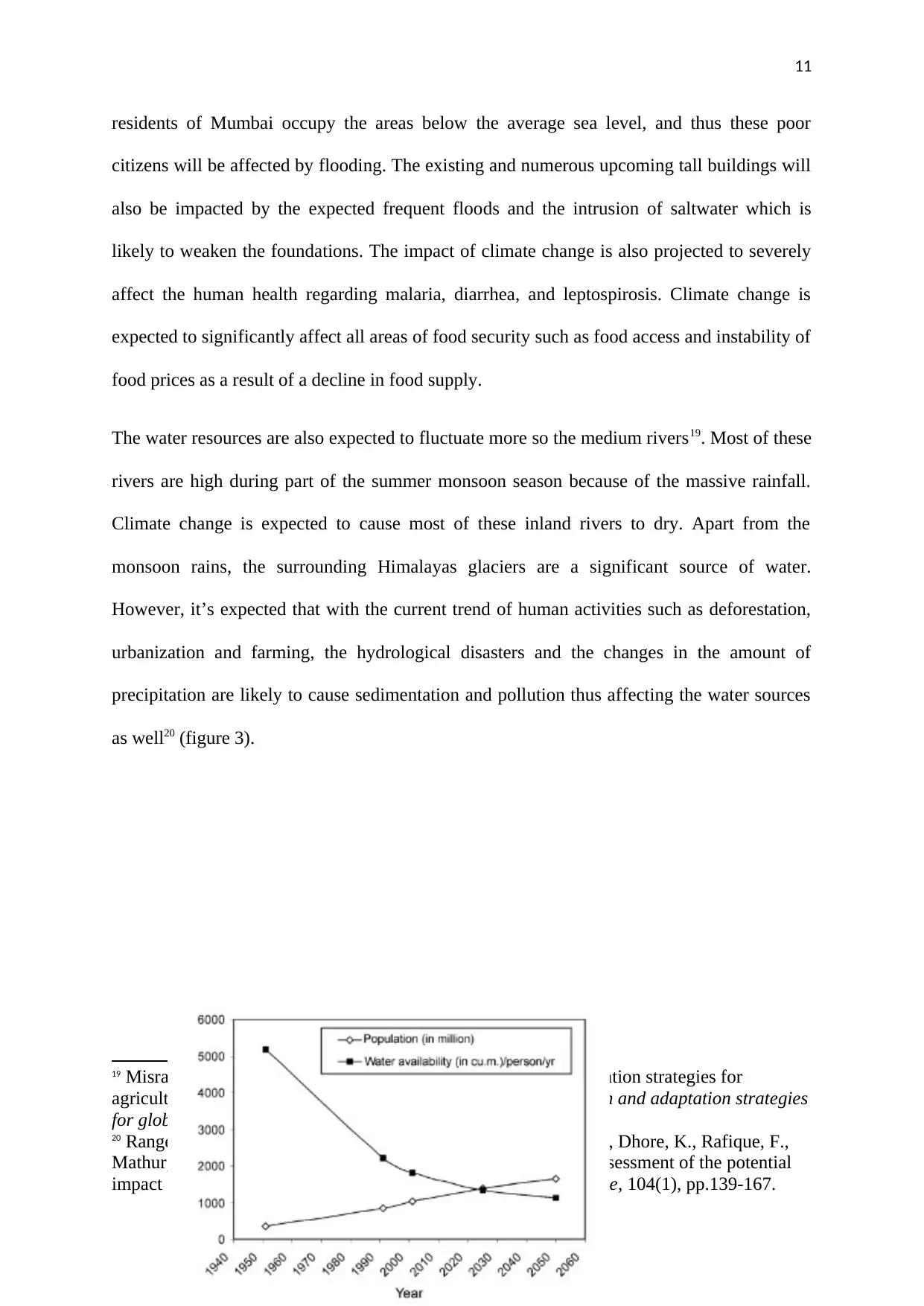
11
residents of Mumbai occupy the areas below the average sea level, and thus these poor
citizens will be affected by flooding. The existing and numerous upcoming tall buildings will
also be impacted by the expected frequent floods and the intrusion of saltwater which is
likely to weaken the foundations. The impact of climate change is also projected to severely
affect the human health regarding malaria, diarrhea, and leptospirosis. Climate change is
expected to significantly affect all areas of food security such as food access and instability of
food prices as a result of a decline in food supply.
The water resources are also expected to fluctuate more so the medium rivers19. Most of these
rivers are high during part of the summer monsoon season because of the massive rainfall.
Climate change is expected to cause most of these inland rivers to dry. Apart from the
monsoon rains, the surrounding Himalayas glaciers are a significant source of water.
However, it’s expected that with the current trend of human activities such as deforestation,
urbanization and farming, the hydrological disasters and the changes in the amount of
precipitation are likely to cause sedimentation and pollution thus affecting the water sources
as well20 (figure 3).
19 Misra, A.K., 2013. Climate change impact, mitigation and adaptation strategies for
agricultural and water resources, in Ganga Plain (India). Mitigation and adaptation strategies
for global change, 18(5), pp.673-689.
20 Ranger, N., Hallegatte, S., Bhattacharya, S., Bachu, M., Priya, S., Dhore, K., Rafique, F.,
Mathur, P., Naville, N., Henriet, F. and Herweijer, C., 2011. An assessment of the potential
impact of climate change on flood risk in Mumbai. Climatic change, 104(1), pp.139-167.
residents of Mumbai occupy the areas below the average sea level, and thus these poor
citizens will be affected by flooding. The existing and numerous upcoming tall buildings will
also be impacted by the expected frequent floods and the intrusion of saltwater which is
likely to weaken the foundations. The impact of climate change is also projected to severely
affect the human health regarding malaria, diarrhea, and leptospirosis. Climate change is
expected to significantly affect all areas of food security such as food access and instability of
food prices as a result of a decline in food supply.
The water resources are also expected to fluctuate more so the medium rivers19. Most of these
rivers are high during part of the summer monsoon season because of the massive rainfall.
Climate change is expected to cause most of these inland rivers to dry. Apart from the
monsoon rains, the surrounding Himalayas glaciers are a significant source of water.
However, it’s expected that with the current trend of human activities such as deforestation,
urbanization and farming, the hydrological disasters and the changes in the amount of
precipitation are likely to cause sedimentation and pollution thus affecting the water sources
as well20 (figure 3).
19 Misra, A.K., 2013. Climate change impact, mitigation and adaptation strategies for
agricultural and water resources, in Ganga Plain (India). Mitigation and adaptation strategies
for global change, 18(5), pp.673-689.
20 Ranger, N., Hallegatte, S., Bhattacharya, S., Bachu, M., Priya, S., Dhore, K., Rafique, F.,
Mathur, P., Naville, N., Henriet, F. and Herweijer, C., 2011. An assessment of the potential
impact of climate change on flood risk in Mumbai. Climatic change, 104(1), pp.139-167.
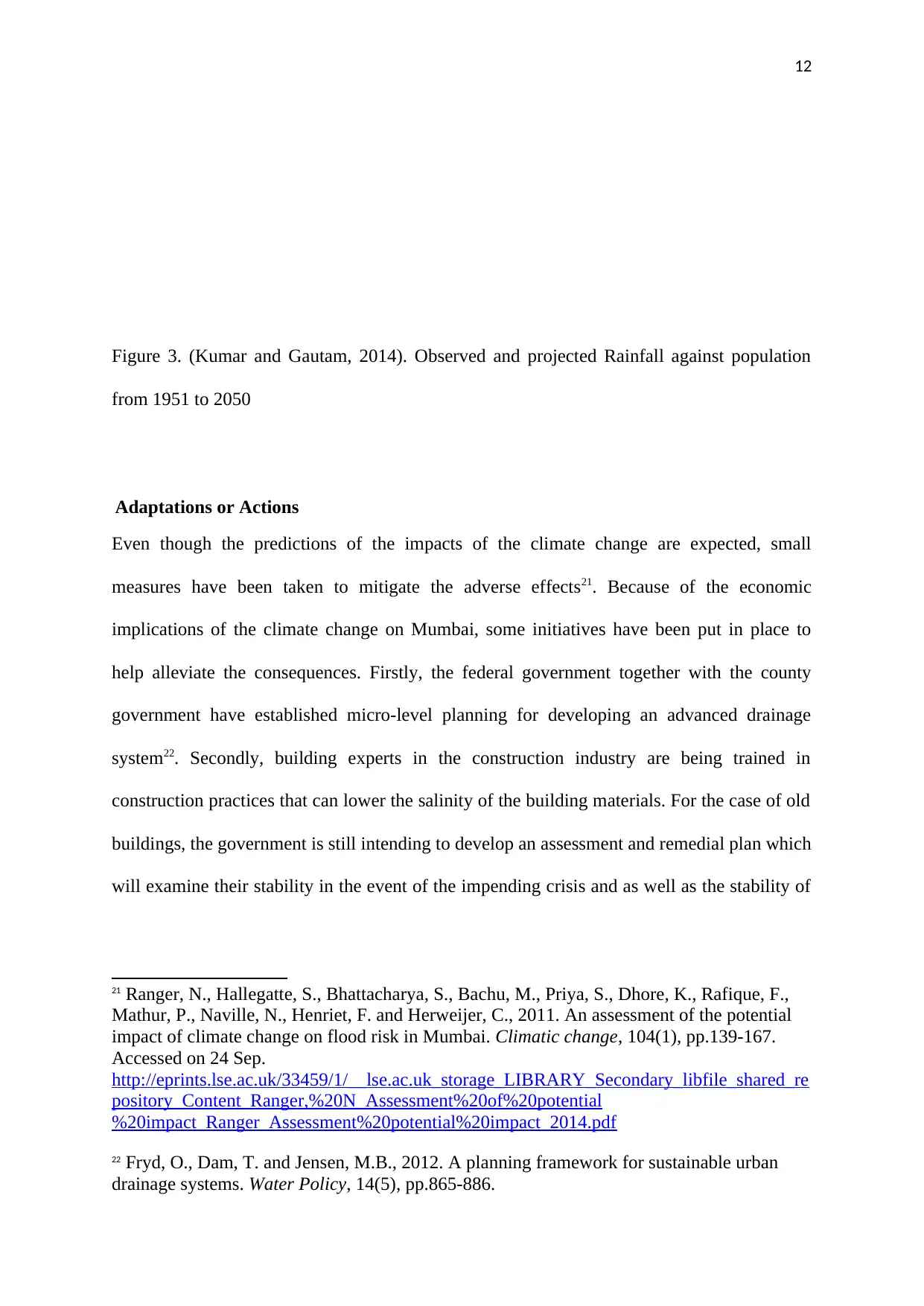
12
Figure 3. (Kumar and Gautam, 2014). Observed and projected Rainfall against population
from 1951 to 2050
Figure 3Observed and projected decline in per capita average annual freshwater availability and growth of population
from 1951
Adaptations or Actions
Even though the predictions of the impacts of the climate change are expected, small
measures have been taken to mitigate the adverse effects21. Because of the economic
implications of the climate change on Mumbai, some initiatives have been put in place to
help alleviate the consequences. Firstly, the federal government together with the county
government have established micro-level planning for developing an advanced drainage
system22. Secondly, building experts in the construction industry are being trained in
construction practices that can lower the salinity of the building materials. For the case of old
buildings, the government is still intending to develop an assessment and remedial plan which
will examine their stability in the event of the impending crisis and as well as the stability of
21 Ranger, N., Hallegatte, S., Bhattacharya, S., Bachu, M., Priya, S., Dhore, K., Rafique, F.,
Mathur, P., Naville, N., Henriet, F. and Herweijer, C., 2011. An assessment of the potential
impact of climate change on flood risk in Mumbai. Climatic change, 104(1), pp.139-167.
Accessed on 24 Sep.
http://eprints.lse.ac.uk/33459/1/__lse.ac.uk_storage_LIBRARY_Secondary_libfile_shared_re
pository_Content_Ranger,%20N_Assessment%20of%20potential
%20impact_Ranger_Assessment%20potential%20impact_2014.pdf
22 Fryd, O., Dam, T. and Jensen, M.B., 2012. A planning framework for sustainable urban
drainage systems. Water Policy, 14(5), pp.865-886.
Figure 3. (Kumar and Gautam, 2014). Observed and projected Rainfall against population
from 1951 to 2050
Figure 3Observed and projected decline in per capita average annual freshwater availability and growth of population
from 1951
Adaptations or Actions
Even though the predictions of the impacts of the climate change are expected, small
measures have been taken to mitigate the adverse effects21. Because of the economic
implications of the climate change on Mumbai, some initiatives have been put in place to
help alleviate the consequences. Firstly, the federal government together with the county
government have established micro-level planning for developing an advanced drainage
system22. Secondly, building experts in the construction industry are being trained in
construction practices that can lower the salinity of the building materials. For the case of old
buildings, the government is still intending to develop an assessment and remedial plan which
will examine their stability in the event of the impending crisis and as well as the stability of
21 Ranger, N., Hallegatte, S., Bhattacharya, S., Bachu, M., Priya, S., Dhore, K., Rafique, F.,
Mathur, P., Naville, N., Henriet, F. and Herweijer, C., 2011. An assessment of the potential
impact of climate change on flood risk in Mumbai. Climatic change, 104(1), pp.139-167.
Accessed on 24 Sep.
http://eprints.lse.ac.uk/33459/1/__lse.ac.uk_storage_LIBRARY_Secondary_libfile_shared_re
pository_Content_Ranger,%20N_Assessment%20of%20potential
%20impact_Ranger_Assessment%20potential%20impact_2014.pdf
22 Fryd, O., Dam, T. and Jensen, M.B., 2012. A planning framework for sustainable urban
drainage systems. Water Policy, 14(5), pp.865-886.
⊘ This is a preview!⊘
Do you want full access?
Subscribe today to unlock all pages.

Trusted by 1+ million students worldwide
1 out of 17
Related Documents
Your All-in-One AI-Powered Toolkit for Academic Success.
+13062052269
info@desklib.com
Available 24*7 on WhatsApp / Email
![[object Object]](/_next/static/media/star-bottom.7253800d.svg)
Unlock your academic potential
Copyright © 2020–2025 A2Z Services. All Rights Reserved. Developed and managed by ZUCOL.





